Reflection
For the forgetting of memory, and the separation of arrival
By Hu Fang
Full Name

Jun Yang and Soldier Woods, 2002, Video, 9 min. Produced for Manifesta 4, 2002.
my name is
Jun Yang /’d║u:n i^n/
Jun is the first name
Yang the family name
in chinese – to be precise in mandarin chinese – it is pronounced
jan chuen /i^n ‘t║u:n/
family name first
my parents on the other hand
are from a region with a different dialect
so when they named me they had a different pronunciation in mind
they would say
Ji chuan /ji: ‘t║u-an/
again family name first
. . .
we left the country when i was 4
and therefore – in some ways we also left this language (1)
Born in Zhejiang province, China, Jun Yang immigrated to Europe with his parents at age four and was raised in Vienna, Austria.
Many years after moving to Vienna, in a video work entitled Jun Yang and Soldier Woods(2002), he humorously recounted how his name, “Jun Yang,” can be “misread” in different socio-cultural contexts, as well as his experiences of growing up with these misreadings and their attendant contradictions.
It was precisely the misreading of his name that triggered the process for Jun Yang of discovering his individuality within socio-cultural constructs, while contemporary art became a means for him to reconstruct the relations between his self and the external world.
We could also say that filmmaking in particular allowed Jun Yang to discover a “Jun Yang” as narrator, a self that exists only in his videos and has a life independent of the Jun Yang that exists in reality.
The Chinese Restaurant
 Still from Coming Home – Daily Structures of life , 2000, Video, 16 min.
Still from Coming Home – Daily Structures of life , 2000, Video, 16 min.
 Installation view of Coming Home – Daily Structures of life (2000), table, chairs, Chinese restaurant ceiling with monitor and video.
Installation view of Coming Home – Daily Structures of life (2000), table, chairs, Chinese restaurant ceiling with monitor and video.
Chinese restaurants were integral to Jun Yang’s development, as he grew up in the same building as the restaurant run by his parents in Vienna, always in sight of the signboard with the restaurant name, Tianjin, done in white Chinese characters in classic Songti script against a blue background – just like the way that was common in 1930s and ’40s China – in a kind of distortion of time and space.
In the film Coming Home – Daily Structures of Life (2000), “I” discusses the experience of growing up in a Chinese restaurant, his narration incorporated throughout in voiceover, while the images that flicker across the screen are in fact scenes shot at Chinese restaurants that were taken from commercial Hollywood movies.
What “I” recounts is essentially the common experience of all Chinese immigrants in the 1970s: they did not open restaurants because they specialized in cooking; they did so as a means of survival. “I” recalls with rich irony:
In the last 20 years we’ve had all different professions in our restaurants:
lawyers, farmers, police officers, doctors, students, artists, butchers or
electricians – but hardly any cooks (2)
The necessities of survival prompted the immigrants to invent their own specialty. Initially the restaurant was a temporary solution, but then through daily processes it became a new structure for living that was distinct from the Western lifestyle framework. At the same time, the restaurant became an extension of the family space. It became the living room, kitchen, study. Moreover, it converted memories of the homeland into a dialogue with the realities of the new locality. The meaning of “home” accordingly migrated beyond the entrenched social system.
As for this “I” raised from youth in a Chinese restaurant, the questions of what to eat, and how to eat, became an interface between his own experiences and Western society: placed before the “stomach,” the preconceptions of ideology inevitably undergo reevaluation.
In this mutual displacement, a new space for existence emerged.
X
 Camouflage – Look like them – Talk like them , 2004, Video, 15 min.
Camouflage – Look like them – Talk like them , 2004, Video, 15 min.
Jun Yang’s films always center upon an individual narrator, just as in the first-person narrative of a novel. Sometimes this “I” is already the protagonist of the narrative, as in A Short Story on Forgetting and Remembering (2007); at other times this “I” is a removed observer, as in Camouflage – Look like them – Talk like them (2004). The so-called “narrative voice” always slips between representing the personality of a fictional character and the critical voice of Jun Yang the filmmaker, such that in the process of its unfolding, the narrative of “I” always manifests a kind of universal experience.
In Camouflage – Look like them – Talk like them, the narrator recounts the classic tale of X, an illegal immigrant from China. X has known nothing but hardship. After moving to a foreign land and city, he cannot understand the language, has no means for social integration, lives in constant fear, and then is caught by the police and put in prison, where he goes on hunger strike seeking amnesty. X recognizes that the only suitable environment for him – the safe route – entails disappearing into the local society, becoming a member of the crowd. He understands that looking and dressing the same – camouflaging himself – is the implication of survival. Through this quiet recounting of X’s story, the narrator discovers the deep contradictions within society. In order to survive, you must make yourself disappear:
When transformation – assimilation – becomes a means of survival
striving for uniqueness as a common goal
when appearance becomes judgment
and judgment becomes deceptive (3)
In this film, Jun Yang develops a visual narrative style that integrates news digests, still images and documentation of scenes from daily life in an exploration of the nonlinear relations between the commentary and the imagery, and in so doing exploits the spatial tension of the filmic narrative in a way that is both unassuming and yet penetrates to the core of the issue at hand.
Fade to Black
Jun Yang first consciously makes use of blank screens in Coming Home – Daily Structures of Life. The sequence of Chinese restaurant scenes taken from Hollywood movies fades into an extended period of blackness, although the off-screen soundtrack continues throughout. While the movie images are mostly reflections of the neon signboards and exotically “Asian” interiors of the restaurants, the blank screen is the exact opposite of that gaudiness.
The extended blank screen seemingly reflects the narrator’s interior sobriety and state of suspension. What “I” describes exists precisely within the blackness that fades in and out of the picture. Even as “I” outwardly refrains from critiquing the ideology of Hollywood movies, he disrupts that ideology through his own narrative.
Neon Signs in the Night
 A short-story on forgetting and remembering , 2007, 16mm film, 20 min.
A short-story on forgetting and remembering , 2007, 16mm film, 20 min.
The neon signs that fill the Asian nightscape are Modernity’s most evocative inscription upon urban space. From the start of Asia’s modernization process, every city has carved out its own new image in neon. A complete integration of light and media, the neon sign in the night sky activates a different urban aesthetics from that of the daylight hours: an excessive, temporary, stimulating, illusory aesthetic. The neon sign creates a man-made visual zone suspended between daylight and darkness, one that is incessantly articulated, emphasizing the power of images.
A young, insomniac protagonist wanders through the Taipei night, climbs up to the rooftop of a building and sits beneath a neon sign. Passing through a hallway suffused with fluorescent light, he enters a 24-hour convenience store. The night seemingly impels him to comb through his past, his family’s past, the city’s past:
the city is somehow in-between
it is in a phase of transition
. . .
as a child my parents didn’t like to talk about their past
it was some sort of troubled past, all too fresh – not digested…
the wounds still open or never really healed
with their thoughts somewhere in-between (4)
It is as though his consciousness has been wrapped in a cocoon.
In the Taipei night, he continues to pass through different spaces. Slowly, viewers discover that his route appears to coincide with the evolution of Taipei’s urban space and the fragmentation of its political situation. At the same time, amid sensations of reflection and movement, the protagonist discovers a secret linking his family and the city: a city whose history has been rewritten by successive waves of immigrants, a space that has been repeatedly reconstructed in order to satisfy the needs and dreams of its inhabitants. There, the boundaries between reality and imagination blur, evoking the glow of the neon signs in the night sky.
A Short Story on Memory and Forgetting was Jun Yang’s first film since his gradual relocation from Europe back to Asia, and the protagonist’s activities all take place at night. Jun Yang found in the movies of Edward Yang, Tsai Ming-liang, Wong Kar-wai and other directors the elements of what he calls an Asian urban “night aesthetics.” Responding to this cinematics, he used 16mm film to shoot this work. However, through his lens, the “night aesthetics” becomes an even more conceptual framework that can be set against a murky, historical blank space: as in the urban night, you can discover secrets that would be impossible to find in daylight.
Outsider
 Still from Paris Syndrome , 2007/08, 16:9 digital video, 10 min.
Still from Paris Syndrome , 2007/08, 16:9 digital video, 10 min.
The narrators in Jun Yang’s films are usually contemplative characters who find themselves banished to the margins, who incessantly question themselves through their observations of their environs and their physical encounters.
They wish to hide from their surroundings:
In fact, to vanish into the masses of people,
to be “one of many”
unrecognizable
was exactly what I was hoping for – I wanted (5)
If Europe is not home, and China is not home, then where is home?
who are you?
what are you?
are you chinese? (6)
He has no way to define himself, yet also has no desire to become someone else:
if they proclaim to belong to each other
do i belong to them
and if not
then
am i on the other side?
am i thus alien and enemy?
if they belong to each other
do i belong to them
and if not
then
where to? (7)
He has no way to define real time:
we also hardly spoke about the future
these dreams were not spoken out loud, but stayed within our minds
no past – no future (8)
He has never had any idols:
my walls were empty
no posters of heroes or role models smiling down (9)
He witnesses a superficially affluent global society, but is filled only with anxieties of indeterminateness:
world fairs were occasions for cultural display as well as to show off
– technical progress, wealth or just the beauty of one’s own country…
these weren’t moments to talk about internal problems but moments to stage (10)
His position can only be revealed through narration – a kind of metaphorical survival. The process of image-making undoubtedly becomes his process for passing through reality to seize an impetus for existence. And all of this implies that in the circumstances of human existence, what is intrinsic is dreaming, and hope.
A Better Tomorrow
 Installation view of A Better Tomorrow , 2006, Exhibition view at Liverpool Biennial, Tate Liverpool, 2006. Video installation with wood-façade construction (6 x 6 x 3.5m), neon, seven green boxes, dvd-video on 16:9 LCD screen, sound; HD video 21min.
Installation view of A Better Tomorrow , 2006, Exhibition view at Liverpool Biennial, Tate Liverpool, 2006. Video installation with wood-façade construction (6 x 6 x 3.5m), neon, seven green boxes, dvd-video on 16:9 LCD screen, sound; HD video 21min.
We always live out various dreams of living (dreams always bear the traces of different ideologies), but the moment when dream and reality meet is fundamentally the moment when conflicts arise between dream and reality. Seeking a solution to this contradiction, a moment of release, is Jun Yang’s particular obsession.
Paris Syndrome (2007) is an architectural study of Guangzhou residential developments that appropriate all the stereotypical architectural “styles” of Europe, from those of Italy and Spain to Germany and Switzerland. Yet, the reality of China, and Chinese pragmatism, also means that the people living in these residences use them in ways never imagined in the West. The film follows a pair of office workers who affect modernity but actually profess their distaste for artificiality as they wander through these developments.
Jun Yang is hardly interested in entering into a simple critique, and instead seeks to excavate the aspirations propping up this architecture. If we agree that a copy is something longing for the real thing, then what is expressed in the copy should also be a kind of desire, a kind of relation of dream and reality. It’s a question of how we package the reality. We have a moment of reality, but this reality is in a way suspended:
Like that building
No second thoughts
No hesitation
No before and no after
Not part of a linear history or narration
But out of longing and dream of the moment (11)
Made for the 2006 Liverpool Biennial, A Better Tomorrow (2006) was produced in Liverpool, but still continues Jun Yang’s research into the city as a “prospective space” for the ideal human life. Once again the protagonist’s narration begins with the story of his parents, but this time the protagonist’s parents have already left “here” (Liverpool) and returned to their homeland. From the start, his parent’s residence “here” was seemingly always motivated by the idea of working toward a better return to the place from which they originally escaped. Confronting the issue of how to deal with the domestic sundries that his parents left behind, the protagonist gradually discovers through this process a perpetual anachronism: their today was for the sake of a better tomorrow, but the image of tomorrow has been constantly deferred, the utopia of the future repeatedly lost, even if it is exactly this perpetual “state of deferral” that drove his parents, the residents of “here,” the city – all progressing relentlessly toward their own transformation.
In a certain sense, the phrase “A Better Tomorrow” itself expresses the paradox of living. A favorite rallying cry of politicians and real estate developers, the phrase can also be dissociated from its usual significance as a staple of advertising slogans, and once again make us confront and acknowledge this fundamental reality of life: we all share the hope, responsibility, power and obligation to live in a “A Better Tomorrow.”
In the installation that Jun Yang created for Liverpool, this exact phrase flashed in neon from above the partitioned structure the artist constructed for the work’s display.
The Woods in Sunlight
 Still from Norwegian Woods ,2008, 16mm Film,18 min
Still from Norwegian Woods ,2008, 16mm Film,18 min
Paralleling the story in A Better Tomorrow, Norwegian Woods (2008) follows a female protagonist who must also deal with the personal effects of her parents. She takes a ferry from the city back to a small island, back to the home of her childhood, and what she confronts there is the inheritance her mother has left her. This is Jun Yang’s first narrative short film with dialogue.
Jun Yang set the film in Norway’s Lofoten Islands in the Arctic Circle, where the natural light has a bewitching quality. As though intentionally contrasting it with the Asian urban “night aesthetics” that appears in A Short Story on Forgetting and Remembering, this film is shot entirely using natural daylight. A blue color field appears between scene transitions, the camera zooming out to reveal that this is either the blue sky or the blue sea.
At the exact moment when the protagonist of A Better Tomorrow cleans up the various effects that his parents left in their old apartment and thinks about why they might have left the city, the female protagonist in Norwegian Woods is also perhaps carefully arranging her mother’s effects by the light of the Arctic Circle. What is interesting is that both protagonists arrive at the same conclusion: saving only a few photographs, books and objects, they take everything else and scatter it in different places across their respective cities. She places clothes in front of the town charity mission, gives books to the library and leaves a tape recorder in the rubbish heap.
Before she leaves town, she holds a small gathering with friends she has not seen in years. Drinking and catching up, they exchange memories together.
Through sharing, transference, dislocation and transformation, the memories of a certain person, of a certain thing, in a certain city, certain country, certain culture, certain plot of land or certain phase in history attain eternity, and create new, unprecedented spaces.
This process turns like the passage of day and night, a never-ending circulation. In Jun Yang’s films, meditation, solitude and sensitivity are to be endured; at other times, the singularly eloquent narrator accompanies us to see the afterglow of the world’s cycles.
The day she leaves the small island, the sunlight resplendent, the protagonist of Norwegian Woods gazes from her balcony at a young girl – wearing her mother’s skirt – as she passes in haste through the crossroads below.
Translated from the Chinese by Andrew Maerkle
1. From screenplay for Jun Yang and Soldier Woods, Jun Yang, 2002.
2. From screenplay for Coming Home – Daily Structures of Life, Jun Yang, 2006.
3. From screenplay for Camouflage – Look like them – Talk like them, Jun Yang, 2002-04.
4. From screenplay for A Short Story on Forgetting and Remembering, Jun Yang, 2007.
5. From screenplay for from salariiman to superman, Jun Yang, 2001.
6. From screenplay for Hero, This is We, Jun Yang, 2005.
7. ibid.
8. From screenplay for A Short Story on Forgetting and Remembering, Jun Yang 2007.
9. Hero, This is We, 2005.
10. ibid.
11. From Jun Yang’s text for do it (Chinese edition, co-edited by Hu Fang and Hans Ulrich Obrist, Vitamin Creative Space, Beijing/Guangzhou, 2008.
(All images: Courtesy the artist and Vitamin Creative Space, Text: Vitamin Archive)
[Further reading]
Jun Yang: Does Europe Matter?
http://www.vitamincreativespace.com/en/?work=the-pavilion-does-europe-matter
A better life, the shop for frieze art fair
http://www.vitamincreativespace.com/en/?artfair=a-better-life-the-shop-for-frieze-art-fair
Jun Yang: Paris Syndrone
http://www.vitamincreativespace.com/en/?work=jun-yang-paris-syndrone







































































